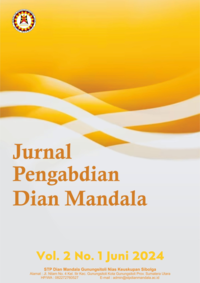Analisis Statistika Multivariat untuk Menilai Keterkaitan Gaya Hidup Digital dengan Tingkat Stres Mahasiswa
DOI:
https://doi.org/10.62200/jpdm.v3i1.226Keywords:
Digital Lifestyle, Digital Stress, Media Social, Multivariate Regression, Student Well-BeingAbstract
Digital lifestyle has become an integral part of university students' daily lives, involving the use of social media, digital devices, and digital content consumption. The development of digital technology has positive impacts, facilitating easy access to information and social interactions. However, excessive use can lead to digital stress, which negatively affects students' mental health. This study aims to identify the key factors influencing students' digital lifestyles and analyze their relationship with stress levels. A quantitative approach with a survey method was employed, using a questionnaire to measure digital lifestyle, including social media usage frequency and digital device interaction duration, along with the Perceived Stress Scale (PSS) to measure students' stress levels. The factor analysis results show that social media usage and prolonged interaction with digital devices are significant factors contributing to students' stress. Furthermore, sleep disturbances and social anxiety were identified as other significant factors associated with increased stress. The multivariate regression analysis confirmed that students who spent more time on social media reported higher stress levels, associated with social anxiety and sleep disturbances caused by digital addiction. This study suggests the importance of managing digital device usage and raising students' awareness of the negative impacts of excessive social media use. The findings imply the need for support from universities and mental health organizations to provide interventions that help students manage their digital lifestyles, reduce stress, and improve their mental well-being.
References
Arslan, A., & Bardakçi, S. (2021). Investigation of the effects of university students' digital addictions on social anxiety levels [Üniversite öğrencilerinin dijital bağımlılıklarının sosyal kaygı düzeyleri üzerindeki etkisinin incelenmesi]. Milli Eğitim, 50(230), 899–922. https://doi.org/10.37669/milliegitim.710703
Chik, V. M., & Brych, V. V. (2025). The digitalisation and its impact on lifestyle and quality of life. Nation's Health (Ukraine), 2025(2), 74–78. https://doi.org/10.32782/2077-6594/2025.2/11
Daisy, A. (2024). Digital mental health education: Alleviating stigma and enhancing well-being in schools. In Advancing sustainable development goals with educational technology (pp. 143–179). https://doi.org/10.4018/979-8-3693-8242-4.ch006
Dinç, A., Altunhan, A., & Tazegül, Ü. (2024). Relationship between digital stress and career stress levels of sports science students. Revista de Psicologia del Deporte, 33(3), 314–322. https://doi.org/10.1016/j.jct.v10n4p25
Giray, L., Nemeño, J., Braganaza, J., Lucero, S. M., & Bacarra, R. (2024). A survey on digital device engagement, digital stress, and coping strategies among college students in the Philippines. International Journal of Adolescence and Youth, 29(1), Article 2371413. https://doi.org/10.1080/02673843.2024.2371413
González, J. H., & García, N. M. R. (2017). La construcción sociocultural de las habilidades digitales en el bachillerato: De la interacción cotidiana al estudio. Revista Mexicana de Investigación Educativa, 22(73), 421–444. https://www.scopus.com/inward/record.uri?eid=2-s2.0-85030087929
Górecki, T., Krzýsko, M., Ratajczak, W., & Wolýnski, W. (2016). An extension of the classical distance correlation coefficient for multivariate functional data with applications. Statistics in Transition New Series, 17(3), 449–466. https://doi.org/10.21307/stattrans-2016-032
Grech, V., & Calleja, N. (2018). WASP (Write a Scientific Paper): Multivariate analysis. Early Human Development, 123, 42–45. https://doi.org/10.1016/j.earlhumdev.2018.04.012
Hazra, A., & Gogtay, N. (2017). Biostatistics series module 10: Brief overview of multivariate methods. Indian Journal of Dermatology, 62(4), 358–366. https://doi.org/10.4103/ijd.IJD_296_17
Heidari, J., & Kellmann, M. (2024). “Use it right”: The relationship between digital media and recovery. In Fostering recovery and well-being in a healthy lifestyle: Psychological, somatic, and organizational prevention approaches (pp. 103–114). https://doi.org/10.4324/9781003250654-9
Huang, S., Lai, X., Zhang, C., Zhao, X., Dai, X., Qi, M., Wang, H., Wang, W., & Wang, Y. (2024). Relationship between adolescents' smartphone stress and mental health: Based on the multiverse-style analysis and intensive longitudinal method. Acta Psychologica Sinica, 56(6), 745–758. https://doi.org/10.3724/SP.J.1041.2024.00745
Jeitziner, L. T., Roos, A.-L., Ruf, A., & Zahn, C. (2022). What if the computer crashes? Findings from an exploratory factor analysis on stressors in online exams. In Proceedings of International Conference of the Learning Sciences (ICLS) (pp. 1948–1949). https://doi.org/10.1007/978-3-030-60347-2_8
Jiang, F. (2021). Research on UI interactivity in digital media art. In Proceedings of the 2021 International Conference on Computer Technology and Media Convergence Design (CTMCD 2021) (pp. 314–317). https://doi.org/10.1109/CTMCD53128.2021.00074
Jiang, Z., Li, X., & Cao, G. (2023). Causes and influence paths of digital stress among social media users [社交媒体用户数字压力成因及影响路径研究]. Journal of Library and Information Science in Agriculture, 35(11), 64–76. https://doi.org/10.13998/j.cnki.issn1002-1248.23-0780
Kherif, F., Ramponi, C., Latypova, A., & Paunova, R. (2023). Premises of computational neuroscience: Machine learning tools and multivariate analyses. In Neuromethods (Vol. 199, pp. 257–271). https://doi.org/10.1007/978-1-0716-3230-7_16
Korneeva, E., Strielkowski, W., Krayneva, R., & Sherstobitova, A. (2022). Social health and psychological safety of students involved in online education during the COVID-19 pandemic. International Journal of Environmental Research and Public Health, 19(21), Article 13928. https://doi.org/10.3390/ijerph192113928
Kupcewicz, E., Grochans, E., Kadučáková, H., Mikla, M., & Jóźwik, M. (2020). Analysis of the relationship between stress intensity and coping strategy and the quality of life of nursing students in Poland, Spain, and Slovakia. International Journal of Environmental Research and Public Health, 17(12), Article 4536. https://doi.org/10.3390/ijerph17124536
Lee, Y., & Lim, S. (2019). Effects of sports activity on sustainable social environment and juvenile aggression. Sustainability (Switzerland), 11(8), Article 2279. https://doi.org/10.3390/su11082279
Ma, X. (2023). Introduction to digital content. In Management for professionals (Part F1481, pp. 3–14). https://doi.org/10.1007/978-981-99-6737-7_1
Maksimenko, A. A., Zolotareva, A. A., & Kashirsky, D. V. (2025). From screens to sleeplessness: How digital stressors are linked to sleep characteristics in the Russian population. Ekologiya Cheloveka (Human Ecology), 32(3), 207–218. https://doi.org/10.17816/humeco646356
Mardea, N. A., & Kristina, S. A. (2020). Stress levels and quality of life among pharmacy students in Yogyakarta, Indonesia. International Journal of Pharmaceutical Research, 12(2), 700–707. https://doi.org/10.31838/ijpr/2020.12.02.0096
Mattern, J., Lansmann, S., & Mersmann, M. (2020). The key is not spending but investing time: Students' time management and the impact on perceived stress and psychological well-being. In 32nd Bled eConference Humanizing Technology for a Sustainable Society (BLED 2019) (pp. 323–344). https://doi.org/10.18690/978-961-286-280-0.18
Mois, G., & Rogers, W. A. (2024). Developing a framework for digital activities of daily living. The Gerontologist, 64(10), Article gnae110. https://doi.org/10.1093/geront/gnae110
Nandagaon, V. S., & Raddi, S. A. (2020). Depression and suicidal ideation as a consequence of academic stress among adolescent students. Indian Journal of Forensic Medicine and Toxicology, 14(4), 4464–4468. https://doi.org/10.37506/ijfmt.v14i4.12344
Nick, E. A., Kilic, Z., Nesi, J., Telzer, E. H., Lindquist, K. A., & Prinstein, M. J. (2022). Adolescent digital stress: Frequencies, correlates, and longitudinal association with depressive symptoms. Journal of Adolescent Health, 70(2), 336–339. https://doi.org/10.1016/j.jadohealth.2021.08.025
Opoku-Acheampong, A., Kretchy, I. A., Acheampong, F., Afrane, B. A., Ashong, S., Tamakloe, B., & Nyarko, A. K. (2017). Perceived stress and quality of life of pharmacy students in University of Ghana. BMC Research Notes, 10(1), Article 115. https://doi.org/10.1186/s13104-017-2439-6
Oztosun, L., Gonzo, F., & Nadda, V. (2023). The impact of digital learning technology on higher education students' mental health. In Perspectives on enhancing learning experience through digital strategy in higher education (pp. 92–109). https://doi.org/10.4018/978-1-6684-8282-7.ch005
Raj, G., Sharma, A. K., & Arora, Y. (2024). Analyzing the effect of digital technology on mental health. In Strategies for e-commerce data security: Cloud, blockchain, AI, and machine learning (pp. 54–82). https://doi.org/10.4018/979-8-3693-6557-1.ch003
Ramachandiran, M., & Dhanapal, S. (2018). Academic stress among university students: A quantitative study of Generation Y and Z’s perception. Pertanika Journal of Social Sciences and Humanities, 26(3), 2115–2128. https://www.scopus.com/inward/record.uri?eid=2-s2.0-85054288002
Ribeiro, Í. J. S., Pereira, R., Freire, I. V., de Oliveira, B. G., Casotti, C. A., & Boery, E. N. (2018). Stress and quality of life among university students: A systematic literature review. Health Professions Education, 4(2), 70–77. https://doi.org/10.1016/j.hpe.2017.03.002
Salman, I., Bajwa, R. S., & Yunus, A. (2025). Association between digital media use and biopsychosocial health of students. Journal of Technology in Behavioral Science. https://doi.org/10.1007/s41347-025-00531-0
Sharma, N., Prabha, C., Khan, F., Rakesh, N., Bali, S., & Piyush. (2025). The impact of digital platforms on learner lives and educational success. In Proceedings of the International Conference on Intelligent Computing and Control Systems (ICICCS 2025) (pp. 902–907). https://doi.org/10.1109/ICICCS65191.2025.10984511
Shibly, F., Shathifa, M., Suheera, M., & Zunoomy, M. (2021). Impact of digital learning on students’ stress in South Eastern University of Sri Lanka. In 2021 5th International Conference on Electrical, Electronics, Communication, Computer Technologies and Optimization Techniques (ICEECCOT 2021) (pp. 536–543). https://doi.org/10.1109/ICEECCOT52851.2021.9707916
Steffani, C. N., & Gunardi. (2022). Enacting alternating least square algorithm to estimate model fit of SEM generalized structured component analysis. Mathematics and Statistics, 10(6), 1239–1246. https://doi.org/10.13189/ms.2022.100610
Sukdee, T., Khajornsilp, J., Netrthanon, S., Pechsri, K., & Ayudhaya, W. S. N. (2021). Factors affecting stress of online learning due to the COVID-19 situation at Faculty of Education, Thailand National Sports University Chonburi Campus. Journal of Curriculum and Teaching, 10(4), 25–33. https://doi.org/10.5430/jct.v10n4p25
Suma, K. G., Sunitha, G., Tabassum, A., Reddy, A. D., Meghana, B., Reddy, C. Y., & Galety, M. G. (2025). Decoding student stress patterns using LightGBM. In Lecture Notes in Networks and Systems (Vol. 1356, pp. 73–82). https://doi.org/10.1007/978-981-96-5238-9_7
Takao, M., & Ishiyama, N. (2021). Effect of career adaptability on subjective well-being of middle-aged and older employees. Sustainability (Switzerland), 13(5), Article 2570. https://doi.org/10.3390/su13052570
Ting, T. T., Lee, K. T., Lim, S. M., Lai, C. C., Omar, M. A., Alin, J., & Meri, A. (2023). Assessing the identity of digital technology in education in the age of digital communication. Online Journal of Communication and Media Technologies, 13(4), Article e202353. https://doi.org/10.30935/ojcmt/13695
Vidal, N. P., Manful, C. F., Pham, T. H., Stewart, P., Keough, D., & Thomas, R. (2020). The use of XLSTAT in conducting principal component analysis (PCA) when evaluating the relationships between sensory and quality attributes in grilled foods. MethodsX, 7, Article 100835. https://doi.org/10.1016/j.mex.2020.100835
Yang, C.-C., & Smith, C. (2024). Digital social multitasking (DSMT) and digital stress among adolescents: A peer norm perspective. Heliyon, 10(10), Article e31051. https://doi.org/10.1016/j.heliyon.2024.e31051
Downloads
Published
How to Cite
Issue
Section
License
Copyright (c) 2025 Jurnal Pengabdian Dian Mandala

This work is licensed under a Creative Commons Attribution-ShareAlike 4.0 International License.










